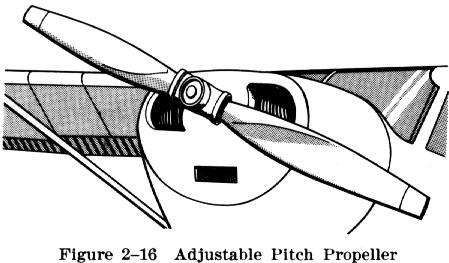Constant Speed Propellers
| In automatically controllable pitch propeller systems, a
control device adjusts the blade angle to maintain a specific preset
engine RPM without constant attention by the pilot (Fig. 2-16). For
example, if engine RPM increases as the result of a decreased load on the
engine, the system automatically increases the propeller's blade angle
(increasing the air load) until the RPM has returned to the preset speed.
A good automatic control system will respond to such small variations in
RPM that, for all practical purposes, a constant RPM will be maintained.
These automatic propellers are termed "constant speed" propellers. |
 |
 |
An automatic system consists of a governor unit which
controls the pitch angle of the blades so that the engine speed remains
constant. The propeller governor can be regulated by the pilot with
controls in the cockpit, so that any desired blade angle setting (within
its limits) and engine operating RPM can be obtained, thereby increasing
the airplane's operational efficiency in various flight conditions. A
low pitch, high RPM setting, for example, can be utilized to obtain
maximum power for takeoff; then after the airplane is airborne, a higher
pitch and lower RPM setting can be used to provide adequate thrust for
maintaining the proper airspeed. This may be compared to the use of low
gear in an automobile to accelerate until high speed is attained, then
shifting into high gear for the cruising speed (Fig.
2-17). |
 |
FAATest.com
- Aviation Library
Dauntless
Software hosts and maintains this library as a service to pilots
and aspiring pilots worldwide. Click
here for ways to show your appreciation for this service.
While much of this material comes from the FAA, parts of it are (c) Dauntless Software, all rights reserved. Webmasters: please
do not link directly to individual books in this library--rather,
please link to our main web page at www.dauntless-soft.com or
www.faatest.com. Thanks! |
|